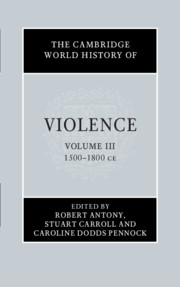Book contents
- The Cambridge World History of Violence
- The Cambridge World History of Violence
- The Cambridge World History of Violence
- Copyright page
- Contents
- Figures
- Maps
- Contributors to Volume iii
- Introduction to Volume iii
- Part I Empire, Race and Ethnicity
- 1 Terror, Horror and the British Atlantic Slave Trade in the Eighteenth Century
- 2 Violence, Slavery and Race in Early English and French America
- 3 Race and Violence in Portuguese America
- 4 Violence and Religion in the Ottoman Empire
- 5 Human Sacrifice, Ritualised Violence and the Colonial Encounter in the Americas
- Part II Cultures of War and Violence
- Part III Intimate and Gendered Violence
- Part IV The State, Punishment and Justice
- Part V Popular Protest and Resistance
- Part VI Religious and Sacred Violence
- Part VII Representations and Constructions of Violence
- Index
- References
1 - Terror, Horror and the British Atlantic Slave Trade in the Eighteenth Century
from Part I - Empire, Race and Ethnicity
Published online by Cambridge University Press: 13 March 2020
- The Cambridge World History of Violence
- The Cambridge World History of Violence
- The Cambridge World History of Violence
- Copyright page
- Contents
- Figures
- Maps
- Contributors to Volume iii
- Introduction to Volume iii
- Part I Empire, Race and Ethnicity
- 1 Terror, Horror and the British Atlantic Slave Trade in the Eighteenth Century
- 2 Violence, Slavery and Race in Early English and French America
- 3 Race and Violence in Portuguese America
- 4 Violence and Religion in the Ottoman Empire
- 5 Human Sacrifice, Ritualised Violence and the Colonial Encounter in the Americas
- Part II Cultures of War and Violence
- Part III Intimate and Gendered Violence
- Part IV The State, Punishment and Justice
- Part V Popular Protest and Resistance
- Part VI Religious and Sacred Violence
- Part VII Representations and Constructions of Violence
- Index
- References
Summary
Violence permeated every aspect of the slave trade. By the late eighteenth century, highlighting the violence in the trade was a central plank of an emerging abolitionist campaign against the institution. The slave trade seemed to presage the worst features of a developing merchant capitalism. It was out of step with rising Enlightenment ideas of sentimental attachment to others. It came to be seen as an almost uniquely horrible industry, one that, however valuable it was to European commerce, needed to be ended as soon as possible. But if the slave trade was a scene of horrors, it also aroused a different emotion – terror. The careful application of violence was central to every part of the slave trade experience. The anticipation of such violence was carefully used as a tool by participants in the trade to keep captive Africans in check, and helps to explain the transformation of African captives into enslaved persons. The terror of the slave trade can be seen graphically in James Field Stanfield’s The Guinea Voyage. Stanfield used mechanistic metaphors to describe the trade. He showed how captives and sailors were kept powerless so that the ‘vast machine’ could make money for British and African merchants.
- Type
- Chapter
- Information
- The Cambridge World History of Violence , pp. 17 - 35Publisher: Cambridge University PressPrint publication year: 2020

